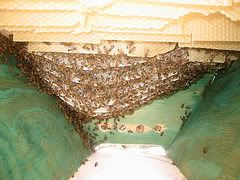On Friday, the same people who's hive I removed over a month ago, called in a panic about the thousands of bees in the air. The thrusday before, they called me about a hive that they found in their decorative roof tiles. It turns out, that the hive is based in the walls; a much bigger problem. The thousands of bees flying through the air were part of a swarm, showing that the bees had been there longer than they thought. I came over as fast as I could and, there was a swarm (probably about 7 pounds) hanging around 15 feet up an oak tree on a limb maybe 1 1/2 inch in diameter. I had been hesitant to capture it, given the possibility that the bees would be africanized. However, today I finally decided that I would take a chance and collect the swarm.
Around 1:00, I headed over to collect the swarm. Trembling with fear, I made my way up the ladder and began brushing the bees into a box. The first brush was the worst. I poorly manuvered the box so, the bulk of the bees fell right onto my veil and chest. It was almost like a bee beard, except, with more fear. At that point, I just about fell off the ladder but, I regained my ballance and got the box under the entire swarm. I sprayed them with about a quart of water and began brusing them into the box, again. When the bulk of them fell in, they felt to be about thet weight of 2 bricks. Now came one of my largest problems, how to manuver the bees and myself down the ladder. In an act of ballancing, I carried the box in the palm of my right hand(just about spilling the bees all over the bushes) and threw the brush down to the grass. Once I had the box on the ground, and in the shade, bees began flying everywhere. In a period of about 20 minutes, all the bees flew strait into the box and, from the some thousand or so that were flying/still on the branch, there were probably 20 bees still flying. I began on my walk home but, the woman who's swarm I was removing offered me a ride home.
When I arived home, the bees were starting to chew their way out of the box and what would fix this problem?MORE TAPE! I began waxing "starter strips" into the Top Bars of my Top Bar Hive and, I would for the next two hours. After this entire process was complete, I packed up the box of bees and everything else into the car and, keeping my veil on, went over to the location of my Russian hive.
I set up the Top Bar Hive on some bricks and made room to shake in the package. Since capturing them, the bees had stopped buzzing and vibrating, so, I was worried that they may have been smothered. I opened up the box and, with the first slit, the bees suddenly came to life. There were THOUSANDS of bees in the box and, I began shaking them into the TBH. They formed a large, buzzing clump in the bottom. They began taking flight and, formed a mass in the air so thick that, they appeared like gnats in the sunset. I noticed that they were all flying back to the box, so I shook those bees at the enterance and they clustered all over the front of the hive. I got a quick look at the queen running around the front, before she was engulfed by her daughters. The bees were all starting to clearly accept their new home and, after hours of working on the bees and the hive, I decided that was enough for one day and, I fugured I'd check on the other three hives tomarrow, and, I'll get a quick peak at the captured swarm hive, just to see how they're doing.





